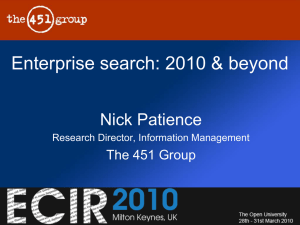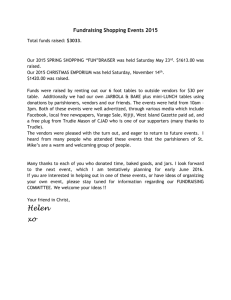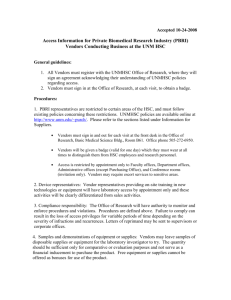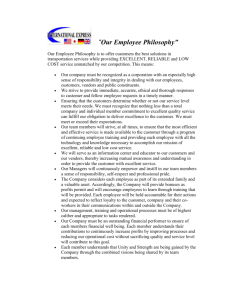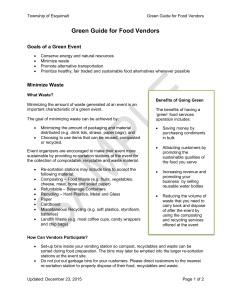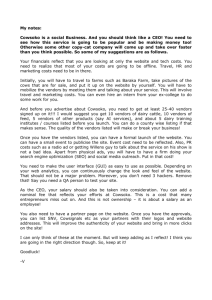Electronic Markets and Geographic Competition among
advertisement
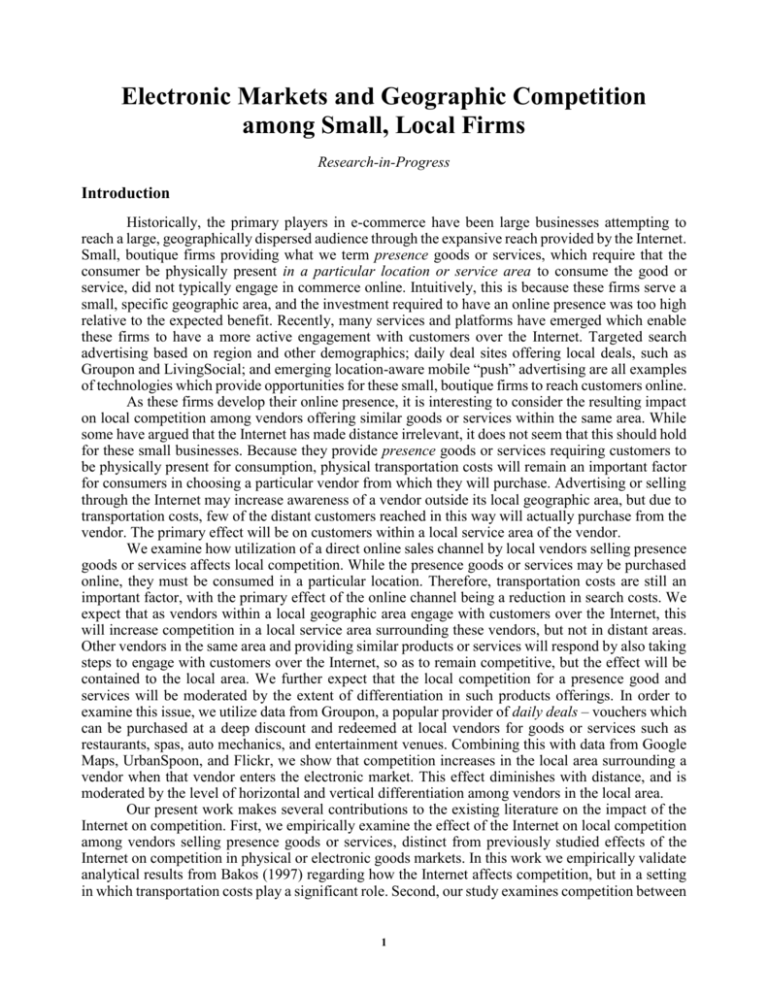
Electronic Markets and Geographic Competition
among Small, Local Firms
Research-in-Progress
Introduction
Historically, the primary players in e-commerce have been large businesses attempting to
reach a large, geographically dispersed audience through the expansive reach provided by the Internet.
Small, boutique firms providing what we term presence goods or services, which require that the
consumer be physically present in a particular location or service area to consume the good or
service, did not typically engage in commerce online. Intuitively, this is because these firms serve a
small, specific geographic area, and the investment required to have an online presence was too high
relative to the expected benefit. Recently, many services and platforms have emerged which enable
these firms to have a more active engagement with customers over the Internet. Targeted search
advertising based on region and other demographics; daily deal sites offering local deals, such as
Groupon and LivingSocial; and emerging location-aware mobile “push” advertising are all examples
of technologies which provide opportunities for these small, boutique firms to reach customers online.
As these firms develop their online presence, it is interesting to consider the resulting impact
on local competition among vendors offering similar goods or services within the same area. While
some have argued that the Internet has made distance irrelevant, it does not seem that this should hold
for these small businesses. Because they provide presence goods or services requiring customers to
be physically present for consumption, physical transportation costs will remain an important factor
for consumers in choosing a particular vendor from which they will purchase. Advertising or selling
through the Internet may increase awareness of a vendor outside its local geographic area, but due to
transportation costs, few of the distant customers reached in this way will actually purchase from the
vendor. The primary effect will be on customers within a local service area of the vendor.
We examine how utilization of a direct online sales channel by local vendors selling presence
goods or services affects local competition. While the presence goods or services may be purchased
online, they must be consumed in a particular location. Therefore, transportation costs are still an
important factor, with the primary effect of the online channel being a reduction in search costs. We
expect that as vendors within a local geographic area engage with customers over the Internet, this
will increase competition in a local service area surrounding these vendors, but not in distant areas.
Other vendors in the same area and providing similar products or services will respond by also taking
steps to engage with customers over the Internet, so as to remain competitive, but the effect will be
contained to the local area. We further expect that the local competition for a presence good and
services will be moderated by the extent of differentiation in such products offerings. In order to
examine this issue, we utilize data from Groupon, a popular provider of daily deals – vouchers which
can be purchased at a deep discount and redeemed at local vendors for goods or services such as
restaurants, spas, auto mechanics, and entertainment venues. Combining this with data from Google
Maps, UrbanSpoon, and Flickr, we show that competition increases in the local area surrounding a
vendor when that vendor enters the electronic market. This effect diminishes with distance, and is
moderated by the level of horizontal and vertical differentiation among vendors in the local area.
Our present work makes several contributions to the existing literature on the impact of the
Internet on competition. First, we empirically examine the effect of the Internet on local competition
among vendors selling presence goods or services, distinct from previously studied effects of the
Internet on competition in physical or electronic goods markets. In this work we empirically validate
analytical results from Bakos (1997) regarding how the Internet affects competition, but in a setting
in which transportation costs play a significant role. Second, our study examines competition between
1
small, boutique vendors, which typically may not be studied in such a large scale, due to issues in
collecting data for a large number of small firms. We are not aware of any other studies that examine
such firms using objective economic data. Small businesses comprise 46% of private-sector output,
and 48.5% of private-sector employment (U.S. Small Business Association 2014), and research on
such a large and unstudied segment of the economy is valuable. Third, we provide empirical evidence
of the moderating role of vertical and horizontal differentiation on competition among firms in a local
geographic area. Fourth, we provide a novel approach for analyzing competition in a geographic area
using a variety of publicly available datasets. Our approach of identifying the clusters of a vendor
type in a geographic area using publicly available Flickr and Google Maps datasets can be used in
future studies to examine the effect of a variety of factors on local competition.
Theory
Geographic competition in its simplest form is epitomized by the Hotelling model, in which
customers experience different transportation costs in purchasing from competing firms (Hotelling
1929). Transportation costs, which may represent distance or other preferences, form the basis of
consumer choice, given that consumers are aware of all vendors, prices, and qualities. This, however,
may not be the case, and consumers must incur search costs to determine which vendor is the best fit.
Hence, consumers face a trade-off between transportation costs (lack of fit) and search costs. A feature
of the Internet is that it serves to lower search costs (Bakos 1997). If vendors can transport their goods
or services directly to consumers, transportation costs are reduced as well. With reduced search and
transportation costs and a large number of firms competing, competition may become intense due to
the impact of the Internet, leading to low price dispersion and profits (Brynjolfsson and Smith 2000).
Several studies empirically examine effects on competition from interplay of the Internet and
geographic location. Blum and Goldfarb (2006) show that even if digital goods are available from
vendors in various locations, consumers tend to transact with vendors who are closer to them. Forman,
Ghose, and Goldfarb (2009) and Brynjolfsson, Hu, and Rahman (2009) examine the competition
between online and brick-and-mortar retailers, finding that physical retailers in an area diminish
online demand. Granados, Gupta, and Kauffman (2012) study differences in price elasticity in online
and offline channels for air travel, finding online channels more elastic. Pozzi (2013) examines the
impact of supermarkets introducing online channels which reduce transportation costs for consumers,
showing that this allows capture of additional market share with little cannibalization (p. 580).
These empirical investigations all share several common characteristics. First, they focus on
the ability of the Internet and online channels to reduce transportation costs. Search costs may also
be considered, but transportation costs play a large role. Second, they examine commodity goods that
are virtually identical across the online and offline vendors from which consumers choose to purchase.
Third, the literature has largely focused on the interplay between brick-and-mortar and online
retailers, typically not the introduction of an online channel to a traditionally brick-and-mortar vendor.
Of the studies we mention above, only Pozzi (2013) studies the introduction of an online channel for
an existing brick-and-mortar vendor, but still focuses on transportation costs and commodity goods.
In contrast to existing empirical work in this area, we focus on brick-and-mortar vendors selling
differentiated products. We examine the impact on competition created when certain of these vendors
also sell goods or services through online channels. However, while the sale occurs online, the good
or service still must be consumed at the vendor’s physical location, so transportation costs are
unaffected. The benefit of the online channel is predominantly related to consumer search costs.
In this way, we provide empirical evidence for analytical results regarding search costs (Bakos
1997) and transportation costs (Hotelling 1929). Bakos shows that when customers’ costs of acquiring
product information is high, as in our case, introduction of electronic markets will create pressure for
sellers to increase discounts. The first seller to enter an electronic market will do so to capture buyer
surplus, but this will increase competition in a prisoners’ dilemma, with other sellers also entering
and increasing discounts. Based on this, we propose that when a seller offers a daily deal through
2
Groupon (the electronic market), other sellers will respond in kind, following on by joining Groupon
and offering further discounts. But based on the nature of these vendors, who sell presence goods and
services, transportation costs will confine the competition to a local area. Within a certain area, the
response of competing vendors will be strong, but the effect will dissipate as distance increases.
Beyond this, we investigate the moderating effect of differentiation among vendors on
competition spurred by Groupon. As mentioned, in Hotelling’s model, transportation costs may
represent any dimension upon which preferences differ (Hotelling 1929). Further, Shaked and Sutton
(1982) demonstrate that differentiation among vendors reduces price competition. Based on these
works, we expect that local geographic areas with higher levels of vertical and horizontal
differentiation will be less impacted by the competitive effects of vendors entering the Groupon
electronic market.
Data
We collected data on daily deals served by Groupon. Consumers subscribe to local daily deal
emails provided by Groupon, which are distributed on a daily basis advertising available vouchers
which may be purchased through the Groupon website. Vouchers typically sell for a 50% discount
relative to retail value. Groupon and the vendor split the revenues collected from the sale of vouchers.
Customers redeem purchased vouchers at the vendors’ premises as if they were gift cards. This model
allows brick-and-mortar vendors to sell their presence goods and services through an online channel.
For our analysis, we collected daily deals offered through Groupon over a 17 month period
(7/1/2011–11/30/2012). We collected data for approximately 110,000 deals offered from vendors in
all 187 Groupon locations (called divisions) in North America. To examine the effects of the Internet
on vendors of presence goods or services, we concentrate on only two types of deals: restaurant and
spa/personal care. These two types of deals comprise approximately 40% of all daily deals offered by
Groupon and they unambiguously represent presence goods or services that require customers to be
physically present on vendors’ premises or in a local service area for consumption. Finally, we
randomly selected 60 divisions for the collection of remaining data required for our analysis.
To examine the impact of daily deals on localized competition, we require a knowledge of the
geographic distribution of vendors relative to those vendors offering daily deals. The first step in this
process is to identify the area which Groupon serves in each division. One option would be to define
bounds to include all deals offered for that division. However, Groupon occasionally offers deals in
a division that are redeemable at a faraway location (e.g. a deal offered in Atlanta division but
redeemable in New York), thus division boundaries cannot be determined in this way. Other defined
boundaries such as official city or metropolitan area bounds are unsatisfactory as well. What is
required is a definition of what a consumer would naturally consider the boundaries of a division. For
this, we turn to a project undertaken by Flickr called Shapefiles. Millions of users upload photos to
Flickr on a daily basis, tagged with meta-data including latitude, longitude, and user-input location.
Flickr processed this meta-data to determine natural definitions for “regions” including cities and
other areas representing Groupon divisions. After examining the boundaries for reasonableness, we
adopt these definitions for our division boundaries. We drop all deals offered in a division with
redemption location outside this boundary, as they are irrelevant to local competition.
With division boundaries in hand, we utilize the Google Maps API to collect information
about the spatial distribution of vendors within a division. We use search terms “restaurant” for
restaurant-type vendors, and “spa” and “massage” for spa-type vendors, and collect the locations of
all vendors of these types using a fine grid search within the boundaries of each division. The purpose
of collecting these vendors is to determine the various local service areas in which consumers choose
between vendors. Intuitively, based on transportation costs, consumers will typically limit their choice
of restaurant or spa vendor to those in a specific area in a division that is nearby, rather than
considering the entire division. While customers may occasionally travel across a division for a deal,
largely competition for customers will be concentrated among vendors in specific localized areas.
3
To identify these areas, we use an unsupervised agglomerative hierarchical clustering
algorithm with Ward’s linkage method to classify all vendors of a type into groups based on
geographic proximity. Distance is measured in the Euclidean sense using latitudes and longitudes for
each vendor, with coordinates adjusted using great-circle distance calculations to account for the
Earth’s curvature. Each cluster represents a consumer’s typical choice set of vendors based on
transportation costs. After testing several cluster sizes for reasonableness, we required a minimum of
four clusters for each division, plus additional clusters based on the log of the number of vendors. We
tested other possibilities and found our results to be robust to other reasonable choices for cluster size.
To measure the moderating effects of vertical and horizontal differentiation on the impact of
the Internet on local competition, we collect data regarding the types of cuisine and relative prices for
restaurants in each division from UrbanSpoon.com. Based on location, we assign each listing to a
cluster created from the Google Maps data. For each cluster, we measure horizontal differentiation
based on the distribution of restaurants across the 111 cuisine types assigned by UrbanSpoon. We
measure this distribution using the Herfindahl index, which measures market concentration. We group
vendors by cuisine type and measure market share of the cuisine type as the proportion of vendors
2
offering that cuisine type in a particular cluster. Formally, 𝐻𝐻𝐼𝑘 = ∑𝑞𝜖𝑄(𝑥𝑞𝑘 ⁄ ∑𝑞𝜖𝑄(𝑥𝑞𝑘 )) , where
𝑄 is the set of all possible cuisine types, and 𝑥𝑞𝑘 the number of vendors of cuisine type 𝑞 in cluster 𝑘.
This measure will be higher in clusters with a higher concentration of certain cuisine types signifying
lower horizontal differentiation and more intense competition. Therefore, we expect that a higher
Herfindahl index for a cluster will lead to a more intense effect of the Internet on local competition.
To represent vertical differentiation, we use the price dispersion among vendors in a cluster,
specifically the coefficient of variation (COV) of the prices (measured on a discreet four-point scale)
for vendors in the cluster, 𝜎𝑘𝑝 ⁄𝜇𝑘𝑝 . The higher the coefficient of variation, the higher dispersion of
prices, and less intense the competition. Therefore we expect that a lower coefficient of variation for
a cluster will lead to more intense effect of the Internet on local competition.
Model and Results
We use specification (1) to examine the effect of prior period deals both inside and outside a
competitive cluster on those in the current period after controlling for other observed and unobserved
factors that may influence the number of deals offered:
𝐷𝑒𝑎𝑙𝑠𝑖𝑗𝑘𝑖𝑗 𝑡 = 𝛼𝑖𝑗𝑘𝑖𝑗 + 𝐼𝑡 + 𝛿1 𝐷𝑒𝑎𝑙𝑠𝑖𝑗𝑘𝑖𝑗(𝑡−1) + 𝛿2 𝐷𝑒𝑎𝑙𝑠𝑖𝑗(−𝑘𝑖𝑗)(𝑡−1) + 𝛽 × 𝑋𝑖𝑗𝑘𝑖𝑗 𝑡 + 𝜀𝑖𝑗𝑘𝑖𝑗 𝑡 , (1)
where 𝑖 ∈ {1, 2} denotes the deal category (i.e. restaurant or spa), 𝑗 ∈ {1, 2, … , 60} denotes the
division, 𝑘𝑖𝑗 ∈ {1, 2, … , 𝐾𝑖𝑗 } denotes the cluster identified for deal category 𝑖 in division 𝑗, and 𝑡 ∈
{1, 2, … , 17} denotes the month. 𝐷𝑒𝑎𝑙𝑠𝑖𝑗𝑘𝑖𝑗𝑡 denotes the number of deals offered in category 𝑖 ,
division 𝑗, and cluster 𝑘𝑖𝑗 in period 𝑡. 𝐷𝑒𝑎𝑙𝑠𝑖𝑗(−𝑘𝑖𝑗)𝑡 denotes the number of deals offered in category
𝑖 and division 𝑗 for all clusters other than 𝑘𝑖𝑗 in period 𝑡. 𝑋𝑖𝑗𝑘𝑖𝑗 𝑡 includes controls 𝐷𝑒𝑎𝑙𝑠(−𝑖)𝑗𝑘𝑖𝑗 𝑡
and 𝐷𝑒𝑎𝑙𝑠(−𝑖)𝑗𝑡 . 𝛼𝑖𝑗𝑘𝑖𝑗 denotes combined category-division-cluster fixed effects and 𝐼𝑡 a vector of
dummy variables indicating the month – note these are omitted for brevity in results presented below.
The primary coefficient of interest 𝛿1 represents the effect of prior period deals in a category,
division, and cluster on the number of deals offered in that same category, division, and cluster in the
current period. A positive effect on this variable indicates that deals offered by vendors increase
competition in a local area around the vendors. Coefficient 𝛿2 , on the other hand, represents the effect
of prior period deals offered in a category in all other clusters of the division on the deals offered in
the same category in a particular cluster in the current period. If the Internet promotes localized
competition, we should find a higher and more significant value for coefficient δ1 as compared to δ2.
4
The results of model (1) are presented in Table 1 for both restaurant- and spa-type vendors.
For spas, we find a positive and significant estimate of coefficient δ1 but an insignificant estimate for
coefficient δ2, which indicates that the number of spa deals in a cluster in a division is positively
correlated to the number of spa deals in that cluster in previous period but uncorrelated with the
number of spa deals in all other clusters in that division in previous period. Thus as spa vendors join
the Groupon platform and offer deals, competition is increased in the local service area to which the
vendor belongs. Other spa vendors in the service area respond by also joining Groupon and offering
discounted daily deal vouchers of their own. However, while spa vendors offering daily deals online
increases competition in a local service area, the competitive impact is restricted to this local area.
For restaurant-type vendors, we do not find the same competitive effect. There is no
significant relationship between prior period and current period Groupon restaurant deals in a cluster.
One reason for this discrepancy may be competitive differences, specifically, how spas and
restaurants are differentiated. Restaurants can be highly differentiated, both vertically (e.g. fast food
versus white table) and horizontally (burgers versus seafood). Based on the UrbanSpoon data
collected, we calculated the Herfindahl index for cuisine types in clusters of restaurant vendors,
finding the mean to be 0.08, a very low index indicating significant horizontal differentiation.
Likewise, the mean coefficient of variation for restaurant pricing within clusters is 0.44, indicating
significant vertical differentiation. Based on these measures, it may be that restaurants operate in a
less directly competitive environment than spas, which are less differentiated.
Table 1 – Model (1) Results
Spa
𝐷𝑒𝑎𝑙𝑠𝑖𝑗𝑘𝑖𝑗(𝑡−1)
0.1257***
𝐷𝑒𝑎𝑙𝑠𝑖𝑗(−𝑘𝑖𝑗)(𝑡−1)
0.0080
𝐷𝑒𝑎𝑙𝑠(−𝑖)𝑗𝑘𝑖𝑗(𝑡−1)
0.0950***
𝐷𝑒𝑎𝑙𝑠(−𝑖)𝑗𝑡
0.0127***
Intercept
0.8398***
R2
0.16
N (clusters * months)
5616
Restaurant
-0.0110
0.0182***
0.0424***
0.0040**
0.7164***
0.07
6976
* p < 0.1; ** p < 0.05, *** p < 0.01
Table 2 – Horizontal and Vertical Differentiation Results
Horizontal Differentiation
Vertical Differentiation
High
Low
High
Low
𝐷𝑒𝑎𝑙𝑠𝑖𝑗𝑘𝑖𝑗(𝑡−1)
-0.0558***
0.0876***
-0.0078
0.0571**
𝐷𝑒𝑎𝑙𝑠𝑖𝑗(−𝑘𝑖𝑗)(𝑡−1)
0.0245***
0.0167***
0.0192*
0.0207***
𝐷𝑒𝑎𝑙𝑠(−𝑖)𝑗𝑘𝑖𝑗(𝑡−1)
0.0383***
0.0293***
0.0353***
0.0349***
𝐷𝑒𝑎𝑙𝑠(−𝑖)𝑗𝑡
0.0078**
-0.0021
0.0053
0.0060***
Intercept
1.2704***
0.4512***
1.2506***
0.1289**
R2
0.11
0.05
0.09
0.11
N (clusters * months)
2720
2720
1792
1792
* p < 0.1; ** p < 0.05, *** p < 0.01
To determine if differentiation is the cause of the lack of effect on restaurant competition, we
split our data into high and low differentiation clusters based on cuisine type Herfindahl index of each
cluster for horizontal differentiation, and coefficient of variation of prices for vertical differentiation.
All clusters with higher (lower) than median differentiation are classified as high (low) differentiation
clusters. For each set of clusters, we apply model (1). Results for by level of differentiation are
provided in Table 2. For both horizontal and vertical measures, in clusters with low differentiation
5
and a more competitive environment, we find a significant positive relationship between prior and
current period daily deal offerings. However, for clusters with high differentiation, we find negative
or no relationships. This supports the proposition that both vertical and horizontal differentiation
mediate the effects of electronic marketplaces on local competition among presence good and service
vendors. Those areas with lower (higher) differentiation are affected more (less).
Conclusion
As large numbers of small, local, boutique firms begin to engage in electronic markets, it has
become important to study the effects of this online engagement of customers on local competition.
Previous studies empirically investigating the effects of the Internet on local competition have
focused on large online firms competing against local vendors in markets selling commodity goods.
Instead, we examine only small, local firms selling presence goods which elect to add sales through
an electronic market to their brick-and-mortar business. We find that for these types of firms, entrance
into electronic markets intensifies competition at a local scale, but this effect diminishes with distance.
Further, the effect on competition is moderated by the amount of horizontal and vertical
differentiation among firms within a local service area, with areas having lower differentiation
experiencing a higher impact on competition.
Our findings validate analytical studies such as Bakos (1997), which demonstrate that when
information on product qualities is difficult to obtain, the introduction of electronic markets will
increase competition in the form of price discounts. We validate these findings specifically in a setting
in which transportation costs play a significant role. Additionally, our findings have implications for
small firms selling presence goods, as well as electronic market platforms serving these firms. Firms
considering entering an electronic market should consider the competitive environment in which they
operate and anticipate response from competing firms in their local service area. Platforms serving
these firms may focus sales efforts in less differentiated service locations as deals offered in these
areas will spur the most competitive response, driving subsequent demand for daily deal services.
References
Bakos, J. 1997. “Reducing buyer search costs: Implications for electronic marketplaces,”
Management Science (43:12), pp. 1676–1692.
Blum, B. S., and Goldfarb, A. 2006. “Does the internet defy the law of gravity?,” Journal of
International Economics (70:2), pp. 384–405.
Brynjolfsson, E., Hu, Y., Rahman, M. S. 2009. “Battle of the retail channels: How product selection
and geography drive cross-channel competition,” Management Science (55:11), pp. 1755–1765.
Brynjolfsson, E., and Smith, M. 2000. “Frictionless commerce? A comparison of Internet and
conventional retailers,” Management Science (46:4), pp. 563–585.
Forman, C., Ghose, A., Goldfarb, A. 2009. “Competition between local and electronic markets:
How the benefit of buying online depends on where you live,” Management Science (55:1), pp.
47–57.
Granados, N., Gupta, A., Kauffman, R. J. 2012. “Online and offline demand and price elasticities:
Evidence from the air travel industry,” Information Systems Research (23:1), pp. 164–181.
Hotelling, H. 1929. “Stability in competition,” The Economic Journal (39:153), pp. 41–57.
Pozzi, A. 2013. “The effect of Internet distribution on brick-and-mortar sales,” The RAND Journal
of Economics (44:3), pp. 569–583.
Shaked, A., and Sutton, J. 1982. “Relaxing price competition through product differentiation,” The
Review of Economic Studies (49:1), pp. 3–13.
U.S. Small Business Association. 2014. “Frequently asked questions,” (available at
http://www.sba.gov/sites/default/files/FAQ_March_2014_0.pdf).
6

